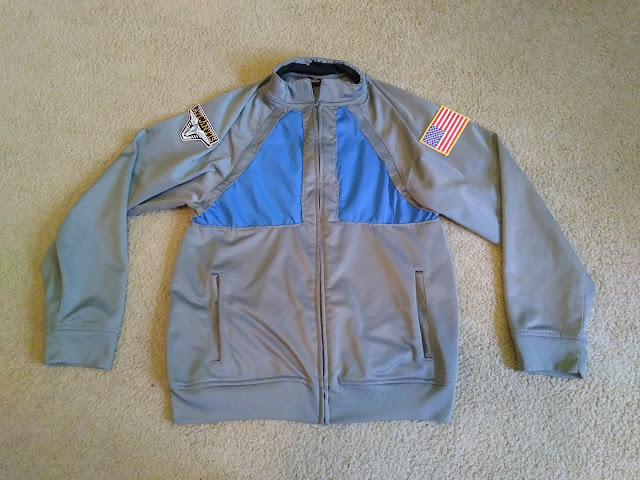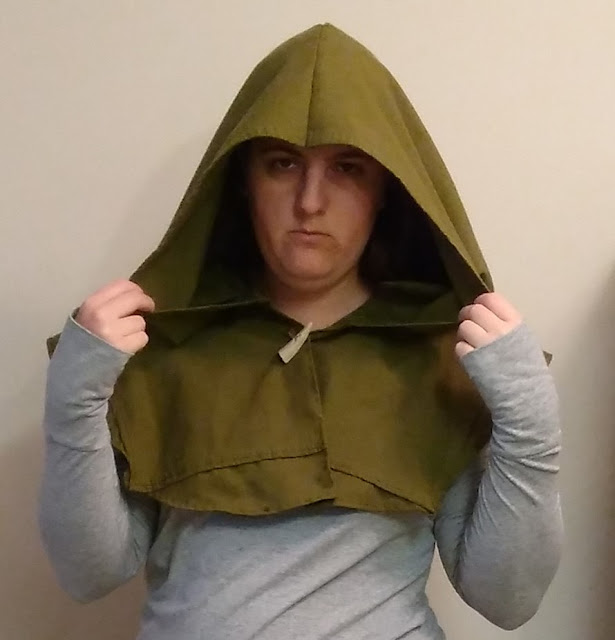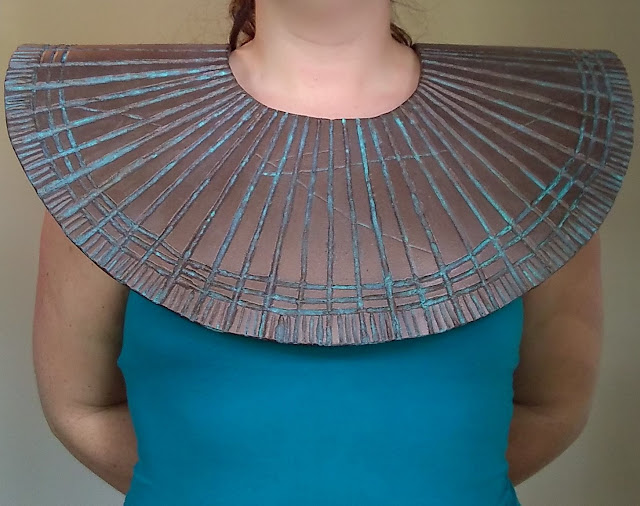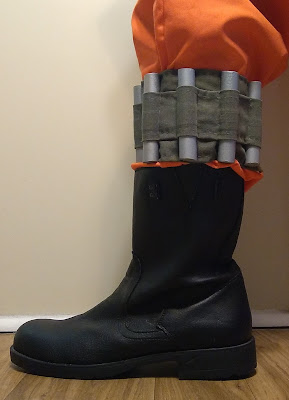How to make a Stargate Atlantis Jacket
Getting ready for a trip to the Pegasus Galaxy? Then perhaps a budget-friendly expedition jacket would not go amiss. Made from a thrift store clothing, some patches, basic tools, and a can-do attitude, you can follow along with this tutorial to make your own version. This tutorial kicks off our run of Stargate-related projects, articles, and costume builds.
For this challenge I drew a lot of inspiration from two tutorials found on the subject. You'll find my process was very much based on Jane's Folly's tutorial, listed below. Jane's Folly modifies an existing jacket, it's a good place to start. Sabinelagrande has a lot of good notes on different versions of the jacket and on making it screen-accurate.
Jane's Folly tutorial: http://janesfolly.org/2012/10/13/stargate-costume/
Sabinelagrande's tutorial: https://sabinelagrande.livejournal.com/198110.html
Reference Images
Materials
-Dark grey athletic jacket
-Blue athletic shirt
-Flag patch
-Atlantis mission patch
-Lightweight interfacing
Tools
-Scissors
-Needle/thread
-Iron
1. Gather the materials
On a hunt through a thrift store, I managed to find a gray athletic jacket and a blue athletic shirt for about $8 combined. The material is similar to the hard-wearing synthetics seen in the series uniforms, though certainly not identical. Problem is, they're not quite color-matched to the uniform in the show. The gray is pretty close, although it is noticeably lighter than the charcoal gray pants I have. I looked through fabric stores among their activewear material, still nothing. With some more time and patience I could likely find something closer without costing an arm and a leg, but for a first attempt it's not too bad.
The other key materials are the patches. There is likely a way to embroider your own version, but since there are commercial versions for cheap I decided to buy them. In the TV show you can see that the flag patches have a gold border, so keep that in mind. There are several versions of Atlantis expedition patches, some more screen-accurate than others. I wasn't all that fussy about it, it's not exact but is very close.
2. Remove the striping
Many of the steps in this tutorial are added in order to remove or cover up design elements that are definitely not on the Atlantis jacket. So if you manage to find a base jacket without black stripes, without a black collar, etc. then congratulations go ahead and skip these steps. But with lower patience and funds comes the increased investment in resourcefulness and sewing time. So with that in mind the first step is to remove the racing stripes.
To do this all I needed was a seam ripper or hobby knife and some patience. The stripes are fabric strips sewn on top of the jacket, so all I needed to do was cut away the stitches that held it in place without cutting into the fabric beneath. Easily done.
But to get rid of the stripes at the cuffs and the collar was a pickle. Ripping out the stitches there would mean disassembling or perhaps even ruining the jacket. I'd have to remove the stitches that attached the cuff to the sleeve, remove the striping, and then re-sew the cuff back onto the sleeve. I decided on a lesser of two evils and managed to trim down the stripes there and then later on covered them up.
3. Create the jacket front
The main modification that needs to be made is to add the color patches. There are several versions of this, but I went with a version seen in earlier seasons. I made a pattern with scrap paper to plan out the location, so that it is about 1inch from the zipper and sleeve seam and extends down about 10 inches from the collar.
Then I traced the pattern onto the jacket and cut out the jacket's front panels. Try to keep the scraps whole, they'll come in handy later for covering the collar.
Then use the pattern to cut out two triangles for the patches out of a sky-blue athletic shirt.
Reinforce the back of the patches with a light- to mid-weight fusible interfacing material. I used an iron to fuse the interfacing to the inward-facing side of the patches. This really gives the material some stiffness, which helps with sewing it into place.
Fold under the raw edges of the gray jacket and pin the patch into place.
Although time-consuming, for this delicate work I sewed it together by hand using a running stitch.
4. Hide the pocket striping
This was easy enough. I cut the top and bottom edges of the stripe, and then folded it under so that it's hidden inside the pocket.
And then I used a whipstitch to make sure the striping stays folded under.
The result should look like this. The stripe is still there, but you'd only know if you turned the pockets inside out.
5. Cover the collar
This is going to be different depending on the jacket, and in some cases totally unnecessary. But for the jacket I went with it has this black stand-up collar that tapers to the zipper. In the reference, the Atlantis jacket is a squared-off edge like a "nehru"-type collar. In the first season there's actually an overlap and velcro closure, but I'm avoiding that. But anyway, I needed to square off the collar, so I took some scraps of mid- to heavy-weight interfacing, cut them to proper shape, and then sewed them onto the collar (don't need to bother with ironing it).
I cut strips of the jacket straps and wrapped it around the collar, being sure to turn down the raw edges. Pinned into place, I then used a running stitch to finish it. The scraps I had didn't have quite enough length to go all the way around uninterrupted, but I was able to get it in three strips.
Fold over the remaining material and trim away excess.
See not bad for scraps from the jacket panels.
6. Cover the leftover striping
There's probably are more artful way to remove the bits of leftover striping on the collar and cuffs, but I went for expediency and covered them up with more scraps.
In order to remove this remnant striping I'd have to rip apart the construction of the jacket itself, so I just decided to cover it instead. Not great but not as blatantly obvious as leaving it in place or as risky as disassembling and then reassembling the jacket.
7. Attach the patches
This part is pretty simple, but positioning needs to be precise so that they match up on both sleeves. For this jacket, I positioned the patches 6 inches away from the collar and in the middle of the sleeve. The middle was easy to judge since there are faint needle marks leftover from where the racing stripes were. The distance from the collar will vary depending on the width of your shoulders, but it should be about 1.5 to 2 inches down from where the shoulder ends. Once I got the ideal position I used a few pieces of masking tape to mark the location.
Following the guidance for using iron-on patches, I heated the sleeve, then positioned the patch, and then ironed on the patch for a few minutes. Then I flipped the sleeve inside out and ironed the other side. It needs to be there long enough to melt the glue on the patch. Then I used some heavy objects to press the patch in place, and waited for it to cool.
In the TV series they make a big deal about having velcro patches so they can remove them when going into "covert" situations, but since the whole point of my jacket is to be an Atlantis jacket I just skipped that part.
And there you have it, a modified thrift store jacket turned into Stargate Atlantis uniform! Good luck and keep crafting!
For this challenge I drew a lot of inspiration from two tutorials found on the subject. You'll find my process was very much based on Jane's Folly's tutorial, listed below. Jane's Folly modifies an existing jacket, it's a good place to start. Sabinelagrande has a lot of good notes on different versions of the jacket and on making it screen-accurate.
Jane's Folly tutorial: http://janesfolly.org/2012/10/13/stargate-costume/
Sabinelagrande's tutorial: https://sabinelagrande.livejournal.com/198110.html
Reference Images
Materials
-Dark grey athletic jacket
-Blue athletic shirt
-Flag patch
-Atlantis mission patch
-Lightweight interfacing
Tools
-Scissors
-Needle/thread
-Iron
1. Gather the materials
On a hunt through a thrift store, I managed to find a gray athletic jacket and a blue athletic shirt for about $8 combined. The material is similar to the hard-wearing synthetics seen in the series uniforms, though certainly not identical. Problem is, they're not quite color-matched to the uniform in the show. The gray is pretty close, although it is noticeably lighter than the charcoal gray pants I have. I looked through fabric stores among their activewear material, still nothing. With some more time and patience I could likely find something closer without costing an arm and a leg, but for a first attempt it's not too bad.
The other key materials are the patches. There is likely a way to embroider your own version, but since there are commercial versions for cheap I decided to buy them. In the TV show you can see that the flag patches have a gold border, so keep that in mind. There are several versions of Atlantis expedition patches, some more screen-accurate than others. I wasn't all that fussy about it, it's not exact but is very close.
2. Remove the striping
Many of the steps in this tutorial are added in order to remove or cover up design elements that are definitely not on the Atlantis jacket. So if you manage to find a base jacket without black stripes, without a black collar, etc. then congratulations go ahead and skip these steps. But with lower patience and funds comes the increased investment in resourcefulness and sewing time. So with that in mind the first step is to remove the racing stripes.
To do this all I needed was a seam ripper or hobby knife and some patience. The stripes are fabric strips sewn on top of the jacket, so all I needed to do was cut away the stitches that held it in place without cutting into the fabric beneath. Easily done.
But to get rid of the stripes at the cuffs and the collar was a pickle. Ripping out the stitches there would mean disassembling or perhaps even ruining the jacket. I'd have to remove the stitches that attached the cuff to the sleeve, remove the striping, and then re-sew the cuff back onto the sleeve. I decided on a lesser of two evils and managed to trim down the stripes there and then later on covered them up.
3. Create the jacket front
The main modification that needs to be made is to add the color patches. There are several versions of this, but I went with a version seen in earlier seasons. I made a pattern with scrap paper to plan out the location, so that it is about 1inch from the zipper and sleeve seam and extends down about 10 inches from the collar.
Then I traced the pattern onto the jacket and cut out the jacket's front panels. Try to keep the scraps whole, they'll come in handy later for covering the collar.
Then use the pattern to cut out two triangles for the patches out of a sky-blue athletic shirt.
Reinforce the back of the patches with a light- to mid-weight fusible interfacing material. I used an iron to fuse the interfacing to the inward-facing side of the patches. This really gives the material some stiffness, which helps with sewing it into place.
Fold under the raw edges of the gray jacket and pin the patch into place.
Although time-consuming, for this delicate work I sewed it together by hand using a running stitch.
4. Hide the pocket striping
This was easy enough. I cut the top and bottom edges of the stripe, and then folded it under so that it's hidden inside the pocket.
And then I used a whipstitch to make sure the striping stays folded under.
The result should look like this. The stripe is still there, but you'd only know if you turned the pockets inside out.
5. Cover the collar
This is going to be different depending on the jacket, and in some cases totally unnecessary. But for the jacket I went with it has this black stand-up collar that tapers to the zipper. In the reference, the Atlantis jacket is a squared-off edge like a "nehru"-type collar. In the first season there's actually an overlap and velcro closure, but I'm avoiding that. But anyway, I needed to square off the collar, so I took some scraps of mid- to heavy-weight interfacing, cut them to proper shape, and then sewed them onto the collar (don't need to bother with ironing it).
I cut strips of the jacket straps and wrapped it around the collar, being sure to turn down the raw edges. Pinned into place, I then used a running stitch to finish it. The scraps I had didn't have quite enough length to go all the way around uninterrupted, but I was able to get it in three strips.
Fold over the remaining material and trim away excess.
See not bad for scraps from the jacket panels.
6. Cover the leftover striping
There's probably are more artful way to remove the bits of leftover striping on the collar and cuffs, but I went for expediency and covered them up with more scraps.
In order to remove this remnant striping I'd have to rip apart the construction of the jacket itself, so I just decided to cover it instead. Not great but not as blatantly obvious as leaving it in place or as risky as disassembling and then reassembling the jacket.
7. Attach the patches
This part is pretty simple, but positioning needs to be precise so that they match up on both sleeves. For this jacket, I positioned the patches 6 inches away from the collar and in the middle of the sleeve. The middle was easy to judge since there are faint needle marks leftover from where the racing stripes were. The distance from the collar will vary depending on the width of your shoulders, but it should be about 1.5 to 2 inches down from where the shoulder ends. Once I got the ideal position I used a few pieces of masking tape to mark the location.
Following the guidance for using iron-on patches, I heated the sleeve, then positioned the patch, and then ironed on the patch for a few minutes. Then I flipped the sleeve inside out and ironed the other side. It needs to be there long enough to melt the glue on the patch. Then I used some heavy objects to press the patch in place, and waited for it to cool.
In the TV series they make a big deal about having velcro patches so they can remove them when going into "covert" situations, but since the whole point of my jacket is to be an Atlantis jacket I just skipped that part.
And there you have it, a modified thrift store jacket turned into Stargate Atlantis uniform! Good luck and keep crafting!































This is sabinelagrande. Your jacket came out great!
ReplyDeleteThis is sabinelagrande. Your jacket came out great!
ReplyDelete